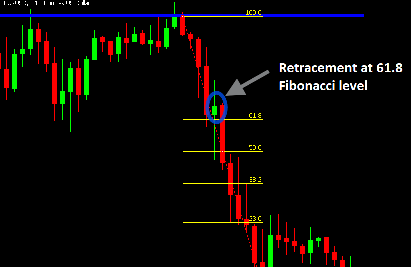In an upward trend, there are points where buyers exit the market either to secure their profits or cut their losses; so, this causes price to fall temporarily (red candles) & this is called a downward retracement.
The same scenario plays out in a downward trend when short sellers begin to exit the market by buying & this causes the price to rise briefly & this is an upward retracement.
It’s tricky to differentiate between a retracement and the beginning of a new trend; & this is what the Fibonacci Retracement tool is for.
You want to anticipate these retracements before they happen, because some traders build their trading strategy around retracements.
The Fibonacci Retracement is a tool that draws lines depicting possible areas of support & resistance where retracements could happen.
You should first draw your support & resistance lines manually (using the horizontal line tool), then add the Fibonacci levels so anywhere they coincide is also an area of value for you.
For accuracy, Fibonacci Retracement should only be applied in an upward or downward trend & the Fibonacci icon can be found in your toolbar.
How to Trade with Fibonacci Retracement

When you spot an ongoing trend on the charts, you click on the Fibonacci icon then use your cursor to draw a line connecting the opening of the first candle on the trend to the closing of the last candle on the trend.
You will notice some support/resistance lines with Fibonacci numbers from 0 to 100 overlaid on your chart.
Each time price approaches these lines, there’s a probability a retracement will occur especially around the 38.2%, & 61.8% lines, as these are considered golden Fibonacci numbers.
Fibonacci Retracement helps you in trading because it lets you identify false trend reversals which could just be retracements.
If you see a reversal occurring at a golden Fibonacci number, it’s likely it’s just a retracement & not a trend reversal.
You can also prepare to trade retracements, but this can be risky because retracements may not last for long before the primary trend continues.
So, if you notice an upward retracement in a downward trend, you can quickly buy & then sell when the retracement is over.
If you notice a downward retracement in an upward trend, you can quickly sell then buy & exit the market when the retracement is over. Either way you make a profit.

Leave a Reply